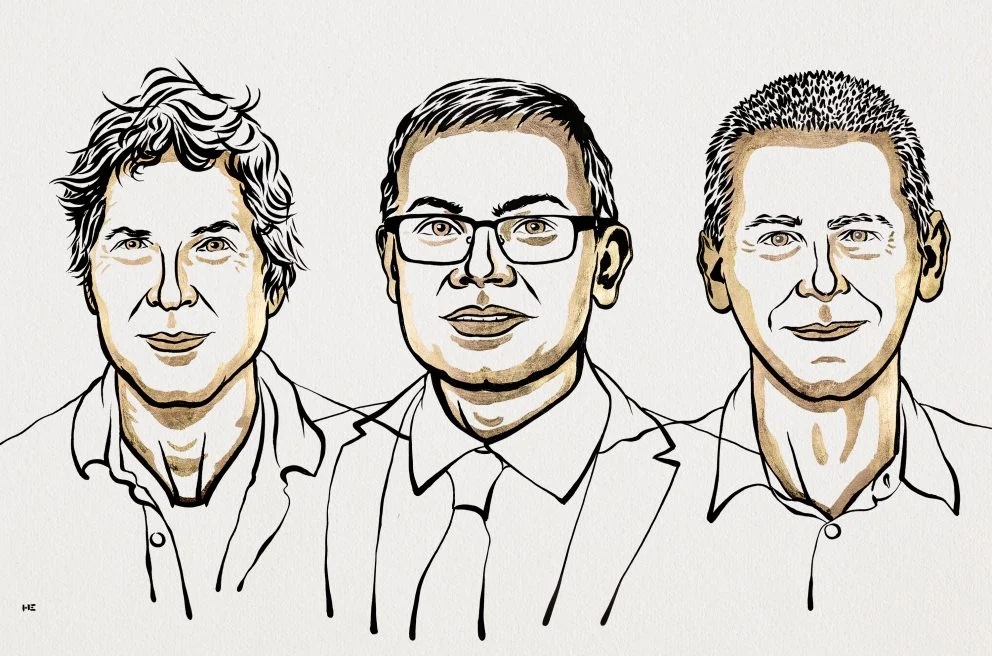Nobel Prize in Chemistry honors advancement in understanding of protein folding
David Baker, Demis Hassabis and John Jumper awarded for advancements in protein design and structure prediction
Marta Hill • October 9, 2024

David Baker, Demis Hassabis and John Jumper, the 2024 Nobel Prize in Chemistry laureates. [Credit: Niklas Elmehed © Nobel Prize Outreach]
This year’s Nobel Prize in Chemistry went to three innovators who have advanced human understanding of the very building blocks of life: proteins.
David Baker, a biochemistry professor at the University of Washington, as well as Demis Hassabis and John M. Jumper of Google DeepMind in London, were jointly awarded this year’s prize.
Proteins are responsible for every process in all living things, ranging from copying DNA to enabling immune responses. They’re made up of long sequences of amino acids which fold up into highly specific structures that dictate the protein’s function. There are endless possibilities for how these amino acids combine — and therein lies the difficulty.
“It has long been a dream to learn to predict the three dimensional structure of proteins from knowing their amino acid sequence, which is encoded in the DNA. For several decades this was considered impossible,” said Heiner Linke, the chair of the Nobel Committee for Chemistry during a press conference announcing the award.
The 2024 Nobel Prize in Chemistry recognizes closely related breakthroughs in two areas of protein research: protein design and protein structure prediction.
In 2003, Baker’s research group designed a new protein, entirely different from all known variants. This protein, called Top7, made it clear that scientists could design proteins from scratch instead of relying on pre-existing structures, according to the Nobel Prize Committee.
Since then, Baker’s research has produced a variety of proteins with wide ranging implications, from virus inhibitors to fentanyl sensors to vaccine development.
A computer software called Rosetta makes this work possible. It submits a proposed protein structure and returns an amino acid sequence that would create that structure.
“It is a mind-blowing development and it’s almost as if it’s only your imagination that sets the limit for what you can do here,” said Johan Åqvist, a member of the Nobel Committee for Chemistry during the press conference.
Protein structure prediction goes hand in hand with protein design. For years, scientists could only predict the 3-dimensional structure of proteins based on their amino acid sequence with about 40% accuracy. Hassabis and Jumper’s AI model, AlphaFold, changed the game.
In 2020, Google DeepMind’s AlphaFold2, an artificial intelligence model that uses neural networks and deep learning to predict the structure of proteins, was able to predict protein structures with about 90% accuracy.
Before this innovation, it could take years to obtain a protein structure. Now it can be done in a few minutes. AlphaFold2 has wide-reaching scientific applications, including in improving our understanding of antibiotic resistance and exploring enzymes that can decompose plastic, according to the Nobel Prize Committee. The software has been used to predict the structure of all 200 million known proteins.
“Life could not exist without proteins,” the press release reads. “That we can now predict protein structures and design our own proteins confers the greatest benefit to humankind.”
At the conference, Baker said he is looking forward to how this technology can be applied to health, medicine and other fields. “I am really excited about all the ways in which protein design can now make the world a better place,” he said.